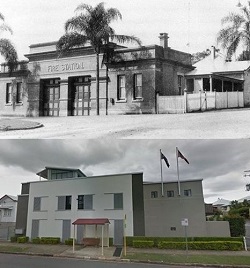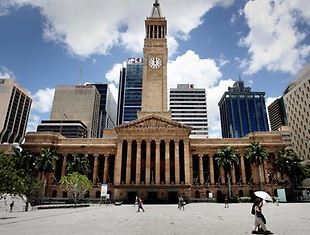
Brisbane, Poor Brisbane
 They say you should never go back. This is an adage I have (mostly) followed all my adult life, and when I have challenged it, invariably I have proved the wisdom and rightness of the advice. The context of the initial experience is so firmly cemented in memory that the process of adjustment to the new reality can be viciously disturbing. The cognitive dissonance involved in experiencing the new reality is usually painful, because it requires a re-assessment of the earlier experiences, and may corrode whatever idealistic memory remains of them.
They say you should never go back. This is an adage I have (mostly) followed all my adult life, and when I have challenged it, invariably I have proved the wisdom and rightness of the advice. The context of the initial experience is so firmly cemented in memory that the process of adjustment to the new reality can be viciously disturbing. The cognitive dissonance involved in experiencing the new reality is usually painful, because it requires a re-assessment of the earlier experiences, and may corrode whatever idealistic memory remains of them.
When I grew up in Brisbane, in the ’30s, ’40s and ’50s, it was a sprawling provincial town of gravel roads and nightsoil trucks, at once complacent and deeply envious of the hated “south”. The antagonism bubbled away, fed by politicians and newspapers, and without the release of a State of Origin series, it seeped into the character of Queenslanders so that their innate inferiority was counterbalanced by pride in their difference as “banana-benders”.
Queensland had virtually no manufacturing industry. Its budget relied on industries all subject to the vagaries of world commodity prices – wool, meat, gold, coal, wheat, sugar, copper and zinc. So when its only two publicly listed companies – Mt Isa Mines and CSR were either taken over or re-domiciled, the lamentations about being reduced to a vassal state were loud and long. That was symptomatic of the victimhood thinking.
Today, the tourism blurbs and restaurant reviewers will have you believe that it’s not like that any more – that Brisbane has grown up, is modern, cosmopolitan, sophisticated, like Sydney or Melbourne. Don’t you believe it! A few pretentious eateries do not a great city make.
When I drove in and was confronted with the skyline of the inner city, I realised nothing had changed. The pathetic insecurity is now expressed vertically in what can only be termed architectural penis envy.
In an absurdly small triangle of land that constitutes the CBD – from North Quay to Circular Quay – Brisbane has tried to stake its claim to be a “real” city by throwing up a forest of 30-, 40-, 50-storey buildings. What are left of the genuine, gracious 19th and early 20th century public buildings are now either smothered or built over to steal their valuable air space. In the process, the city has created windswept canyons, deeply overshadowed open spaces and foregone the opportunity to retain a townscape which was once comfortable for its human scale.
I first worked on the top floor of Pennys Building in Queen Street, where the ABC News Service began in the state. At six storeys Pennys was then the tallest in town. Now it’s possible to go to a viewing platform in a tower block not far away, nearly ten times the height. The satisfaction is looking down on one’s fellow citizens as ants.
 In sixty years a lot of things happen; incremental changes that the inhabitants scarcely notice year by year burst on the consciousness like a pop art re-working of an old master. The confusion is exaggerated by the mental conflict between geographical certainty, enabling me to head in the right direction, and new expressways, bridges, unfamiliar buildings and one-way systems which got me lost.
In sixty years a lot of things happen; incremental changes that the inhabitants scarcely notice year by year burst on the consciousness like a pop art re-working of an old master. The confusion is exaggerated by the mental conflict between geographical certainty, enabling me to head in the right direction, and new expressways, bridges, unfamiliar buildings and one-way systems which got me lost.
Fortitude Valley fire station (left) in 1905 and its eye-wateringly ugly replacement.
Brisbane was the only capital city that called its town hall the City Hall (below right). The pride in its clock tower which dominated the skyline has been forgotten now that is dwarfed by skyscraper office blocks. Down below it, King George Square hosts an underground car park and above that, an open-air platform that, on my visit, had been turned into a facsimile of an oriental bazaar with the tents of an international food festival, plus an ice-skating rink for the kiddies.
Eating, it seems, is the principal occupation of the denizens of Brisbane. On almost every street corner of the CBD, there is a gaggle of eateries offering coffee and fast food of every type. I was not surprised to be told that none was doing well in the  crowded space.
crowded space.
To be cool, Queen Street, the main corso from the river to Circular Quay, has been debauched into a pedestrian mall with a string of food stalls, one of them on two levels pretending to be an exclusive restaurant. Someone had the appalling idea that the street must be covered, so a series of unmatched crazily-arched stainless steel structures was erected, obscuring the only things worth seeing – the facades of the grand old buildings that flank the street, such as The Telegraph Newspaper, the Carlton Hotel, the Queensland National Bank. Premier Joh Bjelke-Petersen earned part of his notoriety by demolishing historic buildings. Today, they rarely do that, they simply turn them into temples of Mammon.
At the top end of Queen Street, the stately Treasury building is now a casino, while behind it the matching Land Administration Building has become a “heritage” hotel. At the bottom end of the street, the beautifully-proportioned Customs House with its dome is now – you guessed it – home to a series of restaurants and luncheon snackeries.
Brisbane once boasted a world-class tramcar service. The spider’s web of lines linked every suburb to the centre. A tram took me to school for a penny, and over the years the rolling stock progressed from the open “toast rack” models to streamlined full-enclosed and weatherproof trams. Forty years after Peter Weir’s horror/comedy film The Cars that ate Paris captivated audiences, the car is devouring Brisbane. The trams are gone, but private vehicles more than fill the spaces they left. The Australian Bureau of Statistics reports that Greater Brisbane’s population of 2.3 million has almost one vehicle for every man woman and child – this on a median income of $49,500!
The narrow colonial streets are so unable to cope with the deluge that the city council has built new expressways over the river. The latest is being built on piles driven into the river at Hamilton to make a six lane road. Toll roads snake through the city – all built on over-optimistic traffic forecasts. A new bridge imaginatively called the “Go-Between Bridge” carries almost no traffic because it is tolled, while unimproved roads, old corners and junctions constitute choke-points that make driving a nightmare. The result of expressway building is that it’s easy to cross the city or go around it, but just as difficult as ever to go anywhere within it.
Paradoxically, Brisbane continues to spread outward while it indulges in an orgy of central high-rise development. In 1924, when twenty suburban councils were abolished under state legislation to set up the Brisbane City Council, it was proudly claimed that Brisbane was the biggest city in the world by area. It was probably a lie then, but it’s certainly not true today. The Brisbane local government area, run by the BCC is 134,000 ha, but even the Greater Capital City Statistical Area recognised by the ABS, of 1.5 million ha ranks only 39th on the world scale.
The Brisbane skyline is festooned with cranes in an apartment-building boom. Something like 2500 new apartments will come on the market in the next twelve months – at a time of historically low population growth, when nearly 60% of units are for rental.
The Reserve Bank has warned of a glut caused by a long pipeline of developments, just as the demand from interstate and foreign buyers is declining. Recently Assistant Governor Michele Bullock said banks could face systemic issues in a downturn; apartments would be the first things unloaded, crashing prices and destroying hopes of capital gain. Brisbane seems to be imitating the Gold Coast’s penchant for boom and bust.
Meanwhile, more suburbs are being added on the fringes, even though it means their residents have to travel congested kilometres on inadequate roads through old, decaying suburbs and, sometimes, swathes of bushland to get there. It seems that despite the convenient locations of higher density developments, Brisbane residents believe units are for tourists or foreigners and a home means a house, no matter how far out.
The bitter sectarianism that bedevillled all sectors of society sixty, seventy years ago may have gone, but what has replaced it seems to be a meaningless hedonism. Corruption continues, unsolved and unexplained. The capital city is a bubble of unreality, as remote from the rest of Queensland as it was in the 1860s when the first campaign for a separate, northern state was launched. Brisbane has changed, but behind the shiny glass and stainless steel, it is just the same.
Geoffrey Luck was an ABC journalist for 26 years
Madam: Archbishop Fisher (July-August 2024) does not resist the attacks on his church by the political, social or scientific atheists and those who insist on not being told what to do.
Aug 29 2024
6 mins
To claim Aborigines have the world's oldest continuous culture is to misunderstand the meaning of culture, which continuously changes over time and location. For a culture not to change over time would be a reproach and certainly not a cause for celebration, for it would indicate that there had been no capacity to adapt. Clearly this has not been the case
Aug 20 2024
23 mins
A friend and longtime supporter of Quadrant, Clive James sent us a poem in 2010, which we published in our December issue. Like the Taronga Park Aquarium he recalls in its 'mocked-up sandstone cave' it's not to be forgotten
Aug 16 2024
2 mins








